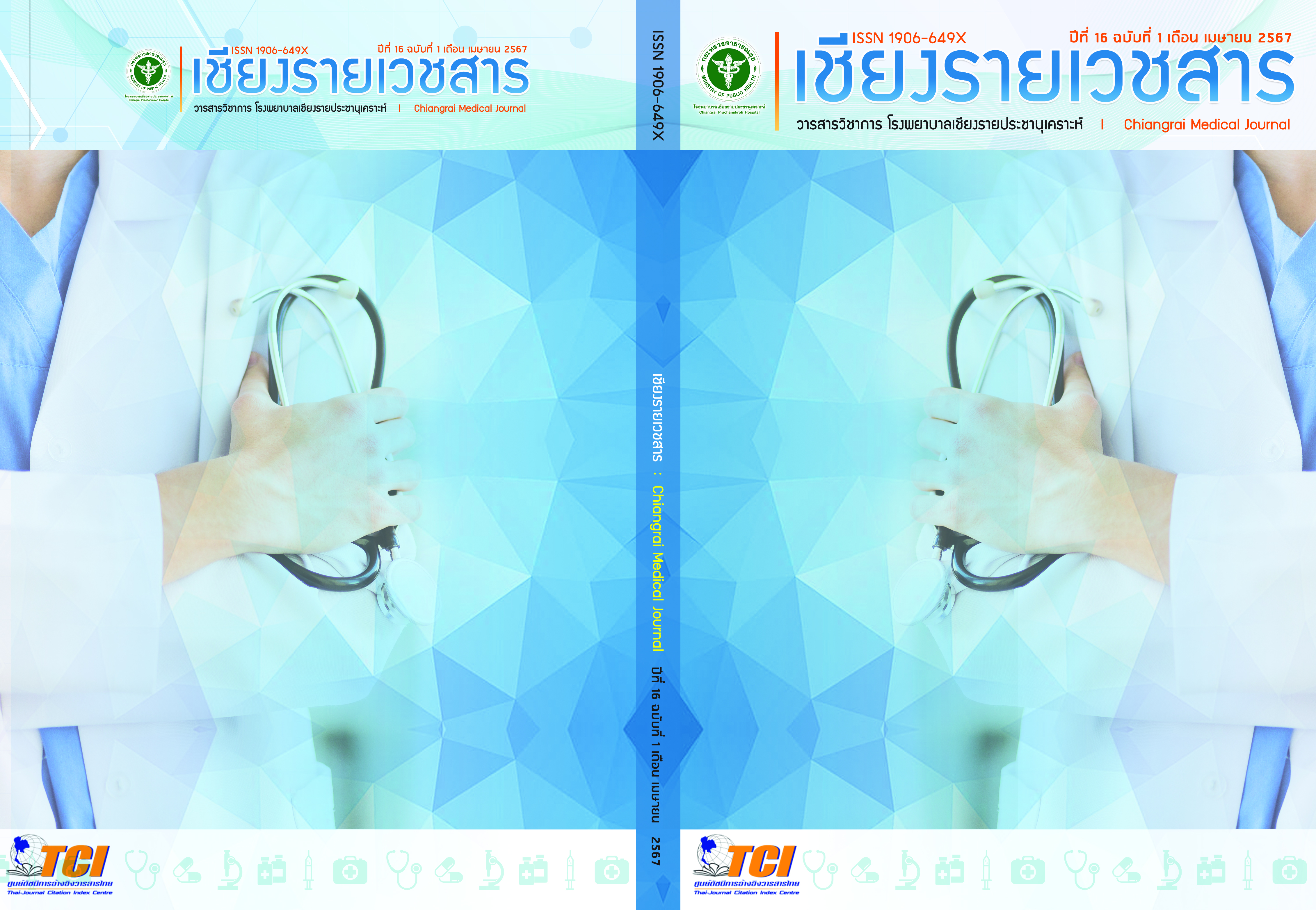ความสัมพันธ์ระหว่างค่าคะแนนความเสี่ยงต่อการหกล้มด้วยแบบประเมิน Thai-FRAT กับความสามารถในการเคลื่อนไหว และความแข็งแรงของกล้ามเนื้อขาในผู้สูงอายุ
Main Article Content
บทคัดย่อ
ความเป็นมา ปัจจุบันได้มีการพัฒนาแบบประเมิน Thai Falls Risk Assessment Test (Thai-FRAT) มาใช้ในการประเมินหาความเสี่ยงในการหกล้มในผู้สูงอายุไทยอย่างแพร่หลาย ทั้งในโรงพยาบาล และในชุมชน อีกทั้งยังเป็นแบบประเมินความเสี่ยงในการหกล้มหนึ่งที่ถูกบันทึกไว้ในแนวทางเวชปฏิบัติการป้องกัน และประเมินภาวะหกล้มในผู้สูงอายุของกรมการแพทย์ กระทรวงสาธารณสุข แต่ยังไม่เคยมีการนำแบบประเมิน Thai-FRAT ที่ถูกพัฒนาขึ้นมาหาความสัมพันธ์กับการทำงานของร่างกายจริงในผู้สูงอายุจากแบบประเมินที่ใช้วัดการทำงานของร่างกาย
วัตถุประสงค์ เพื่อศึกษาค่าความสัมพันธ์ระหว่างค่าคะแนนความเสี่ยงต่อการหกล้มด้วยแบบประเมิน Thai-FRAT กับความสามารถในการทรงตัวในผู้สูงอายุโดยใช้แบบทดสอบ TUG และความแข็งแรงของกล้ามเนื้อขาโดยใช้แบบทดสอบ 30 second chair stand test และ การวัดขนาดเส้นรอบวงน่อง
วิธีการศึกษา: ทำการศึกษาในอาสาสมัครอายุ 65-79 ปี จำนวน 52 ราย ที่มีภูมิลำเนาอยู่ในเขตตำบลแม่ตืน อำเภอลี้ จังหวัดลำพูน โดยรวบรวมข้อมูลจากการสัมภาษณ์ ตอบแบบประเมิน และทดสอบหาความสัมพันธ์โดยใช้สถิติ Pearson’s correlation test กำหนดระดับนัยสำคัญที่ p-value≤ 0.01
ผลการศึกษา พบว่าแบบประเมิน Thai-FRAT มีความสัมพันธ์ระดับปานกลางในทิศทางเดียวกันกับ TUG อย่างมีนัยสำคัญทางสถิติ ( r = 0.59, P-value < 0.001) และ มีความสัมพันธ์ระดับปานกลางในทิศทางตรงกันข้าม กับ 30 second stand test อย่างมีนัยสำคัญทางสถิติ ( r = -0.61, P-value < 0.001) ส่วนความสัมพันธ์ระหว่าง Thai-FRAT กับเส้นรอบวงน่อง ไม่พบความสัมพันธ์ในทางสถิติ
สรุปและข้อเสนอแนะ : แบบประเมิน Thai-FRAT สามารถนำมาใช้คัดกรองความเสี่ยงในการหกล้มแทนแบบทดสอบ TUG และ 30 second stand test ได้ในระดับหนึ่ง ทั้งนี้อาจต้องใช้ประเมินควบคู่กันเพื่อความแม่นยำ
Article Details

อนุญาตภายใต้เงื่อนไข Creative Commons Attribution-NonCommercial-NoDerivatives 4.0 International License.
เอกสารอ้างอิง
Institute of Geriatric Medicine Department of Medical Services, Ministry of Public Health. The importance of preventing falls in the elderly in hospitals. Nonthaburi; 2008.
Institute of Geriatric Medicine Department of Medical Services, Ministry of Public Health. Guidelines for preventing falls in elderly people. Nonthaburi; 20๑๙.
Rubenstein LZ. Falls in older people: epidemiology, risk factors and strategies for prevention. Age Ageing. 2006;35 Suppl 2:ii37-ii41.
Jitapunkul S, Songkhla MN, Chayovan N, Chirawatkul A, Choprapawon C, Kachondham Y, et al. Falls and their associated factors: a national survey of the Thai elderly. J Med Assoc Thai. 1998;81(4):233-42.
National Collaborating Centre for Nursing and Supportive Care (UK). Clinical practice guideline for the assessment and prevention of falls in older people. Royal College of Nursing (UK) 2004; 21:19-24.
Todd C, Skelton DA. What are the main risk factors for falls amongst older people and what are the most effective interventions to prevent these falls? WHO Regional Office for Europe Health Evidence Network report 2018; 11: 4-28.
Perell KL, Nelson A, Goldman RL, Luther SL, Prieto-Lewis N, Rubenstein LZ. Fall risk assessment measures: an analytic review. J Gerontol A Biol Sci Med Sci. 2001;56(12):M761-6.
Luangpon N, Kiatkulanuson S, Kiatkulanuson B, Kittiwarawut J. Relationship between fall risk score, time up and go and weight-bearing balance on lower extremities in elderly people. Christian University Journal 2019;26(1):1-12.
Thiamwong L,Thamarpirat J , Maneesriwongul W, Jitapunkul S. Thai falls risk assessment test (Thai-FRAT) developed for community-dwelling Thai elderly. J Med Assoc Thai. 2008;91(12): 1823-32.
Podsiadlo D, Richardson S. The timed "Up & Go": a test of basic functional mobility for frail elderly persons. J Am Geriatr Soc. 1991;39(2):142-8.
Rikli RE, Jones CJ. Functional Fitness Normative Scores for Community-Residing Older Adults, Ages 60-94. Journal of Aging and Physical Activity. 1999;7(2):129-61.
Erdfelder E, Faul F, Buchner A. GPOWER: a general power analysis program. Behavior research methods, instruments & computers. 1996;28(1);1–11.
Diaz VG, Parodi JF, Merino TA, Perez AC, Castro VG, Runzer CFM. Calf circumference and risk among Peruvian older adults. Eur Geriatr Med. 2016;7:543-6.
Rolland Y, Lauwers-Cances V, Cournot M, Nourhashémi F, Reynish W, Rivière D, et al. Sarcopenia, calf circumference, and physical function of elderly women: a cross-sectional study. J Am Geriatr Soc. 2003;51(8):1120-4.
Chen BB, Shih TT, Hsu CY, Yu CW, Wei SY, Chen CY, et al. Thigh muscle volume predicted by anthropometric measurements and correlated with physical function in the older adults. J Nutr Health Aging. 2011;15(6):433-8.
Loram ID, Maganaris CN, Lakie M. Paradoxical muscle movement in human standing. J Physiol. 2004;556(Pt 3):683-9.
Felson DT, Niu J, McClennan C, Sack B, Aliabadi P, Hunter DJ, et al. Knee buckling: prevalence, risk factors, and associated limitations in function. Ann Intern Med. 2007;147(8):534-40.
Kokot T, Malczyk E, Muc-Wierzgoń M. Assessment of Nutritional Status in the Elderly. In: Watson RR, editor. Nutrition and Functional Foods for Healthy Aging. Massachusetts: Elsevier; 2017.p 75–81.
Moreland JD, Richardson JA, Goldsmith CH, Clase CM. Muscle weakness and falls in older adults: a systematic review and meta-analysis. J Am Geriatr Soc. 2004;52(7):1121-9.
Wang PC, Yeh WC, Tsai YW, Chen JY. Calf circumference has a positive correlation with physical performance among community-dwelling middle-aged, older women. Front Public Health. 20229;10:1038491.
Díaz-Villegas G, Parodi JF, Merino-Taboada A, Perez-Agüero C, Castro-Viacava G, Runzer-Colmenares F.M. Calf circumference and risk of falls among Peruvian older adults. European Geriatric Medicine. 2016;7(6):543-6.
Prapanbandit N. A comparison of calf and thigh circumferences between elderly people
with hip fracture due to fall and other causes. Thai Rehabil Med. 2017 27(2):58-63.


